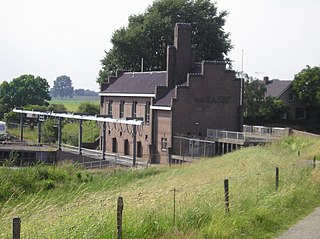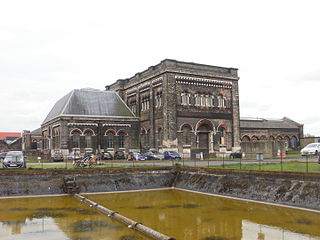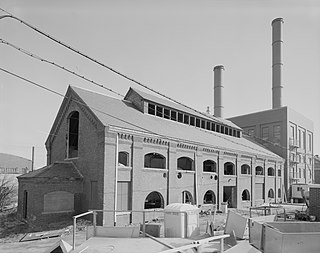
Pumping stations, also called pumphouses in situations such as drilled wells and drinking water, are facilities containing pumps and equipment for pumping fluids from one place to another. They are used for a variety of infrastructure systems, such as the supply of water to canals, the drainage of low-lying land, and the removal of sewage to processing sites. A pumping station is an integral part of a pumped-storage hydroelectricity installation.

Abbey Mills Pumping Station is a sewage pumping station in Mill Meads, East London, operated by Thames Water. The pumping station lifts sewage from the London sewerage system into the Northern Outfall Sewer and the Lee Tunnel, which both run to Beckton Sewage Treatment Works.

The Jerome Park Reservoir is a reservoir located in Jerome Park, a neighborhood in the North Bronx, New York City. The reservoir is surrounded by DeWitt Clinton High School, the Bronx High School of Science, Lehman College, and Walton High School.

The Toronto Works and Emergency Services department was responsible for a variety of services.

Stoke Bardolph is a village and civil parish in the Gedling district of Nottinghamshire. The population of the civil parish taken at the 2011 census was 170. It is to the east of Nottingham, and on the west bank of the River Trent. Nearby places include Burton Joyce and Radcliffe on Trent.

The Crossness Pumping Station is a former sewage pumping station designed by the Metropolitan Board of Works's chief engineer Sir Joseph Bazalgette and architect Charles Henry Driver. It is located at Crossness Sewage Treatment Works, at the eastern end of the Southern Outfall Sewer and the Ridgeway path in the London Borough of Bexley. Constructed between 1859 and 1865 by William Webster, as part of Bazalgette's redevelopment of the London sewerage system, it features spectacular ornamental cast ironwork, that Nikolaus Pevsner described as "a masterpiece of engineering – a Victorian cathedral of ironwork".

Sewage treatment is a type of wastewater treatment which aims to remove contaminants from sewage to produce an effluent that is suitable to discharge to the surrounding environment or an intended reuse application, thereby preventing water pollution from raw sewage discharges. Sewage contains wastewater from households and businesses and possibly pre-treated industrial wastewater. There are a high number of sewage treatment processes to choose from. These can range from decentralized systems to large centralized systems involving a network of pipes and pump stations which convey the sewage to a treatment plant. For cities that have a combined sewer, the sewers will also carry urban runoff (stormwater) to the sewage treatment plant. Sewage treatment often involves two main stages, called primary and secondary treatment, while advanced treatment also incorporates a tertiary treatment stage with polishing processes and nutrient removal. Secondary treatment can reduce organic matter from sewage, using aerobic or anaerobic biological processes.

The Chemical Building is a historic wastewater treatment building at Field's Point Wastewater Treatment Facility in Providence, Rhode Island. Built in 1900–01, it is one of the two oldest buildings at Providence's main sewage treatment facility. It is a 2-1/2 story brick structure measuring 103 feet (31 m) by 38 feet (12 m). The long facades are divided into 9 bays, separated by brick piers. When originally built, the structure had a concrete first floor, a wooden second floor, and a loft area accessed by catwalks, and was used to hold and deliver chemicals used to neutralize the wastewater arriving via the Ernest Street Sewage Pumping Station. In the 1930s the plant was converted to use an active sludge process, and the interior of the building was altered to be a single large chamber.

The Ernest Street Sewage Pumping Station is an historic wastewater pumping station at Ernest and Ellis Streets near the wastewater treatment facility at Field's Point in Providence, Rhode Island. The surviving elements of the station include a main pumphouse and a smaller screening house, both built in 1897-98 as part of a major effort to modernize Providence's sewage treatment facilities. A third structure, a boiler house, was demolished in 1987, and a tall smokestack was taken down in the 1930s. The main pumphouse is a tall single-story brick structure with a hip roof and Colonial Revival features, and is set near Ernest Street, a short way east of its junction with Allens Avenue. The screening house is a smaller square structure, also with a hip roof, set behind and to the right of the pumphouse. The facility is used to pump raw sewage through an 88-inch main to the treatment facility.

The Reservoir Avenue Sewage Pumping Station is an historic wastewater pumping facility on the south side of the junction of Reservoir and Pontiac Avenues in southern Providence, Rhode Island. From the street it looks like a single-story brick structure with a hip roof, and metal doorways on its north and east elevations. This building stands atop a substantial concrete substructure, which houses a dry well and wet well. The dry well, on the eastern side, houses the pumps, while the wet well, occupies the western two-thirds of the facility. The floor of the interior includes glass blocks for viewing the facilities below, as well as metal trapdoors for accessing the pumps. Manual gate valves on the west side are used to control sewage flow through the west well. This facility is used to pump raw sewage eastward and uphill to a gravity conduit in Rutherglen Avenue. This conduit carries the sewage to the Field's Point treatment facility. The pumping station was built by the city of Providence in 1931, and is now owned by the Narragansett Bay Commission, which operates the region's wastewater treatment facilities.

The Return Sludge Pumping Station, Fields Point Sewage Treatment Plant is an historic wastewater pumping station in the Field's Point Sewage Treatment Facility on Ernest Street in Providence, Rhode Island. It is a rectangular hip-roofed brick and concrete structure, located adjacent to the facility's aeration tanks, and is not readily visible from any public way. The building houses a number of large pumps in a large concrete substructure that is below grade. The facility was built in 1934–35, when the sewage treatment method was changed from a chemical process to a biological one, and is used to return biologically active sludge from the aeration tanks back into the treatment process. The pumps in the building are no longer original, having been replaced several times. The building is one of three to survive in the Field's Point area from the early decades of Providence's wastewater treatment system. the others are the Ernest Street Sewage Pumping Station and the Chemical Building; the Sludge Press House was demolished sometime in the last 30 years.

The Sludge Press House was an historic wastewater treatment facility building at the Fields Point Sewage Treatment Plant at Fields Point, Rhode Island in Providence, Rhode Island. It was a two-story brick structure, located near the center of the Field's Point facility, just east of the Chemical Building. It was about 138 by 51 feet in size, with a hip roof, and was built 1899-1901 as part of Providence's first wastewater treatment system. It housed the facilities used at the end of the treatment process by which remaining solids were dewatered and compressed before final disposal.

The Washington Park Sewage Pumping Station is an historic wastewater pumping facility in Providence, Rhode Island. Its principal visible component is a concrete block structure, finished in stucco and topped by a hip roof, which is about 16 by 16 feet. This building stands atop a large cast-in-place concrete well, in which pumps and gate valves are housed. The facility was built in 1911 to pump raw sewage from the low-lying Washington Park area to the Field's Point wastewater treatment facility, which lies about 1,000 feet (300 m) to the north. The pump station is located well back from the street, behind a low brick distribution facility. It was added to the National Register of Historic Places in 1989.

Bellevue Standpipe is a historic water storage tank on Bellevue Hill at Washington Street and West Roxbury Parkway in the Stony Brook Reservation of Boston, Massachusetts. Built in 1914, it is one of three early 20th-century water tanks built as part of Greater Boston's public water supply. The structure was added to the National Register of Historic Places in 1990.

The Calf Pasture Pumping Station Complex is a historic sewage treatment facility at 435 Mount Vernon Street on Columbia Point in the Dorchester section of Boston, Massachusetts which was built in the 1880s.

Fields Point is a historic park in the Washington Park neighborhood of Providence, Rhode Island jutting into Narragansett Bay right near the Providence River and Route 95.
Architects of the National Park Service are the architects and landscape architects who were employed by the National Park Service (NPS) starting in 1918 to design buildings, structures, roads, trails and other features in the United States National Parks. Many of their works are listed on the National Register of Historic Places, and a number have also been designated as National Historic Landmarks.
Sewage Pumping Station 67 is a heritage-listed sewage pumping station located on Grand Avenue, in the Sydney suburb of Camellia, in the City of Parramatta local government area of New South Wales, Australia. It was designed and built by the Metropolitan Water, Sewerage and Drainage Board from 1929 to 1930. It is also known as SPS 67 and SP0067. The pumping station is owned by Sydney Water. It was added to the New South Wales State Heritage Register on 15 November 2002.

Glasgow Corporation Water Works and its successors have provided a public water supply and sewerage and sewage treatment services to the Scottish city of Glasgow. There were several schemes in the early part of the 1800s, with the Glasgow Company which was established in 1806 pumping filtered water from the River Clyde into the city. The Gorbals Gravitation Water Company was established in 1846, and brought water from reservoirs to the south-west of the city. However, an outbreak of cholera in 1848/1849, in which 4,000 people died, concentrated the minds of Glasgow Council, and in 1855 a scheme to use water from Loch Katrine, 36 miles (58 km) to the north, was authorised. The work required at Loch Katrine was quite modest, and the major construction work was the building of an aqueduct to carry the water to the city by gravity.

Eighth Avenue South Reservoir is a man-made masonry reservoir in Nashville, Tennessee. The reservoir was built on Kirkpatrick's Hill which was the former site of Fort Casino: a Union Army fort in the American Civil War. Completed in 1889, it ruptured in 1912 causing much property damage, and was repaired in 1914. In 1978, it was listed on the National Register of Historic Places listings in Davidson County, Tennessee (NRHP). The reservoir is the largest and oldest working reservoir supplying water to the city of Nashville, and remains in use as of 2022.


















